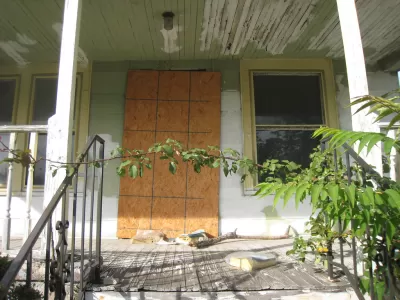On the promise of ownership, rent-to-own landlords make tenants pay for repairs. And on the lower end, homes often come with code violations built in. This market's legal grey spaces distinctly echo 2008.

Alexandra Stevenson and Matthew Goldstein take a deeply critical look at the rising phenomenon of "rent-to-own" deals, where landlords foist repair costs off on their tenants in exchange for a promise of eventual ownership. These deals tend to place all the risk on renters, saving none at all for the landlord.
This is predictably problematic, especially for lower-income tenants. "Most tenants walk away with nothing, having sunk money for rent and repairs into homes they had once hoped to own. Others faced surprise evictions, having signed a contract that did not disclose what repairs were needed, yet set a deadline for making sure the home was up to local housing code."
In many cases, these fair-on-the-face deals conceal legal untidiness and hidden costs that bring the mortgage crisis to mind. "Unlike most typical home purchases, rent-to-own contracts have no requirement to obtain an independent home inspection. The customers contend they were not informed of outstanding issues with Vision homes, many of which the company had bought for $10,000 or less."
Failing to properly fix up these properties carries the risk of eviction. "Tenants who are evicted during the tenure of these seven-year contracts walk away empty-handed, receiving no credit for money spent on repairs or renovations."
What's driving rent-to-own? The same "dream" that drove the mortgage crisis. As one rent-to-own executive argued, "[rent-to-own] is bringing the dream of homeownership to Americans who lack good credit or are too poor to qualify for mortgages."
FULL STORY: Rent-to-Own Homes: A Win-Win for Landlords, a Risk for Struggling Tenants

Planetizen Federal Action Tracker
A weekly monitor of how Trump’s orders and actions are impacting planners and planning in America.

Congressman Proposes Bill to Rename DC Metro “Trump Train”
The Make Autorail Great Again Act would withhold federal funding to the system until the Washington Metropolitan Area Transit Authority (WMATA), rebrands as the Washington Metropolitan Authority for Greater Access (WMAGA).

The Simple Legislative Tool Transforming Vacant Downtowns
In California, Michigan and Georgia, an easy win is bringing dollars — and delight — back to city centers.

The States Losing Rural Delivery Rooms at an Alarming Pace
In some states, as few as 9% of rural hospitals still deliver babies. As a result, rising pre-term births, no adequate pre-term care and "harrowing" close calls are a growing reality.

The Small South Asian Republic Going all in on EVs
Thanks to one simple policy change less than five years ago, 65% of new cars in this Himalayan country are now electric.

DC Backpedals on Bike Lane Protection, Swaps Barriers for Paint
Citing aesthetic concerns, the city is removing the concrete barriers and flexposts that once separated Arizona Avenue cyclists from motor vehicles.
Urban Design for Planners 1: Software Tools
This six-course series explores essential urban design concepts using open source software and equips planners with the tools they need to participate fully in the urban design process.
Planning for Universal Design
Learn the tools for implementing Universal Design in planning regulations.
Smith Gee Studio
City of Charlotte
City of Camden Redevelopment Agency
City of Astoria
Transportation Research & Education Center (TREC) at Portland State University
US High Speed Rail Association
City of Camden Redevelopment Agency
Municipality of Princeton (NJ)





























